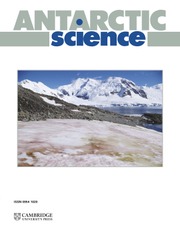Crossref Citations
This article has been cited by the following publications. This list is generated based on data provided by
Crossref.
Harland, Rex
and
Pudsey, Carol J.
1999.
Dinoflagellate cysts from sediment traps deployed in the Bellingshausen, Weddell and Scotia seas, Antarctica.
Marine Micropaleontology,
Vol. 37,
Issue. 2,
p.
77.
Nitsche, Frank O
Cunningham, Alex P
Larter, Rob D
and
Gohl, Karsten
2000.
Geometry and development of glacial continental margin depositional systems in the Bellingshausen Sea.
Marine Geology,
Vol. 162,
Issue. 2-4,
p.
277.
Diekmann, Bernhard
Kuhn, Gerhard
Rachold, Volker
Abelmann, Andrea
Brathauer, Uta
Fütterer, Dieter K
Gersonde, Rainer
and
Grobe, Hannes
2000.
Terrigenous sediment supply in the Scotia Sea (Southern Ocean): response to Late Quaternary ice dynamics in Patagonia and on the Antarctic Peninsula.
Palaeogeography, Palaeoclimatology, Palaeoecology,
Vol. 162,
Issue. 3-4,
p.
357.
Pudsey, C.J
2000.
Sedimentation on the continental rise west of the Antarctic Peninsula over the last three glacial cycles.
Marine Geology,
Vol. 167,
Issue. 3-4,
p.
313.
Barker, Peter F.
2001.
Scotia Sea regional tectonic evolution: implications for mantle flow and palaeocirculation.
Earth-Science Reviews,
Vol. 55,
Issue. 1-2,
p.
1.
Lucchi, R.G.
Rebesco, M.
Camerlenghi, A.
Busetti, M.
Tomadin, L.
Villa, G.
Persico, D.
Morigi, C.
Bonci, M.C.
and
Giorgetti, G.
2002.
Mid-late Pleistocene glacimarine sedimentary processes of a high-latitude, deep-sea sediment drift (Antarctic Peninsula Pacific margin).
Marine Geology,
Vol. 189,
Issue. 3-4,
p.
343.
Rebesco, M.
Pudsey, C. J.
Canals, M.
Camerlenghi, A.
Barker, P. F.
Estrada, F.
and
Giorgetti, A.
2002.
Sediment drifts and deep-sea channel systems, Antarctic Peninsula Pacific Margin.
Geological Society, London, Memoirs,
Vol. 22,
Issue. 1,
p.
353.
Lodolo, E.
Camerlenghi, A.
Madrussani, G.
Tinivella, U.
and
Rossi, G.
2002.
Assessment of gas hydrate and free gas distribution on the South Shetland margin (Antarctica) based on multichannel seismic reflection data.
Geophysical Journal International,
Vol. 148,
Issue. 1,
p.
103.
Harland, Rex
and
Pudsey, Carol J.
2002.
Protoperidiniacean dinoflagellate cyst taxa from the Upper Miocene of ODP Leg 178, Antarctic Peninsula.
Review of Palaeobotany and Palynology,
Vol. 120,
Issue. 3-4,
p.
263.
Bae, Sung Ho
Yoon, Ho Il
Park, Byong-Kwon
and
Kim, Yeadong
2003.
RETRACTED ARTICLE: Late Quaternary stable isotope record and meltwater discharge anomaly events to the south of the Antarctic Polar Front, Drake Passage.
Geo-Marine Letters,
Vol. 23,
Issue. 2,
p.
110.
Bae, Sung Ho
Yoon, Ho Il
Park, Byong-Kwon
Kim, Yeadong
Bahk, Jang Jun
and
Seo, Hyun Seok
2003.
Meltwater discharge anomalies in marine isotope stage 3 from a sediment core in the south of Antarctic Polar Front, Drake Passage.
Geosciences Journal,
Vol. 7,
Issue. 1,
p.
73.
Villa, Giuliana
Persico, Davide
Bonci, Maria Cristina
Lucchi, Renata G
Morigi, Caterina
and
Rebesco, Michele
2003.
Biostratigraphic characterization and Quaternary microfossil palaeoecology in sediment drifts west of the Antarctic Peninsula – implications for cyclic glacial–interglacial deposition.
Palaeogeography, Palaeoclimatology, Palaeoecology,
Vol. 198,
Issue. 1-2,
p.
237.
Santis, Laura De
Brancolini, Giuliano
and
Donda, Federica
2003.
Seismo-stratigraphic analysis of the Wilkes Land continental margin (East Antarctica): influence of glacially driven processes on the Cenozoic deposition.
Deep Sea Research Part II: Topical Studies in Oceanography,
Vol. 50,
Issue. 8-9,
p.
1563.
Maldonado, Andrés
Barnolas, Antonio
Bohoyo, Fernando
Galindo-Zaldı́var, Jesús
Hernández-Molina, Javier
Lobo, Francisco
Rodrı́guez-Fernández, José
Somoza, Luis
and
Tomás Vázquez, Juán
2003.
Contourite deposits in the central Scotia Sea: the importance of the Antarctic Circumpolar Current and the Weddell Gyre flows.
Palaeogeography, Palaeoclimatology, Palaeoecology,
Vol. 198,
Issue. 1-2,
p.
187.
Hillenbrand, Claus-Dieter
Grobe, Hannes
Diekmann, Bernhard
Kuhn, Gerhard
and
Fütterer, Dieter K
2003.
Distribution of clay minerals and proxies for productivity in surface sediments of the Bellingshausen and Amundsen seas (West Antarctica) – Relation to modern environmental conditions.
Marine Geology,
Vol. 193,
Issue. 3-4,
p.
253.
Volpi, V.
Camerlenghi, A.
Hillenbrand, C.‐D.
Rebesco, M.
and
Ivaldi, R.
2003.
Effects of biogenic silica on sediment compaction and slope stability on the Pacific margin of the Antarctic Peninsula.
Basin Research,
Vol. 15,
Issue. 3,
p.
339.
Hillenbrand, Claus-Dieter
and
Ehrmann, Werner
2005.
Late Neogene to Quaternary environmental changes in the Antarctic Peninsula region: evidence from drift sediments.
Global and Planetary Change,
Vol. 45,
Issue. 1-3,
p.
165.
Maldonado, Andrés
Barnolas, Antonio
Bohoyo, Fernando
Escutia, Carlota
Galindo-Zaldívar, Jesús
Hernández-Molina, Javier
Jabaloy, Antonio
Lobo, Francisco J.
Nelson, C. Hans
Rodríguez-Fernández, José
Somoza, Luis
and
Vázquez, Juán-Tomás
2005.
Miocene to Recent contourite drifts development in the northern Weddell Sea (Antarctica).
Global and Planetary Change,
Vol. 45,
Issue. 1-3,
p.
99.
Lodolo, Emanuele
Donda, Federica
and
Tassone, Alejandro
2006.
Western Scotia Sea margins: Improved constraints on the opening of the Drake Passage.
Journal of Geophysical Research: Solid Earth,
Vol. 111,
Issue. B6,
Scheuer, Carsten
Gohl, Karsten
and
Udintsev, Gleb
2006.
Bottom-current control on sedimentation in the western Bellingshausen Sea, West Antarctica.
Geo-Marine Letters,
Vol. 26,
Issue. 2,
p.
90.




